



Underwater archeology - Papers from 2012 to 2014

Authors:
William McVicker, Jeffrey Forrester, Timothy Gambin, Jane
Lehr, Zo¨e J. Wood, and Christopher M. Clark
This paper presents a new method for constructing 2D
maps of enclosed underwater structures using an
underwater robot equipped with only a 2D scanning sonar,
compass, and depth sensor.

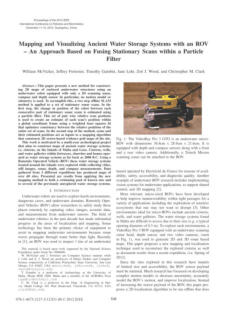

Authors:
A. Caiti, V. Calabr´o, F. Di Corato, T. Fabbri, D. Fenucci, A.
Munafo, B. Allotta, F. Bartolini, R. Costanzi, J. Gelli, N. Monni,
M. Natalini, L. Pugi, A. Ridolfi.
The Thesaurus project, funded by the Tuscany Region, had
among its goals the development of technologies and
methodologies for archaeological search with Autonomous
Underwater Vehicles working as a team in exploration
missions. That has led to designing and realizing a new
AUV class (Typhoon) based on the archaeological
requirements and an appropriate acoustic simultaneous
communication and localization scheme.




This paper examines three of Australia’s earliest port-related
structure studies.
Excavations conducted in 1984 and 1994 in vastly different
circumstances, with markedly different oceanographic
conditions, progressing through quite different substrates,
were joined with 1993–1994 overview of all the port
structures along the coast of Western Australia. Providing a
better appreciation of submerged port-related structure
studies as a bona fide part of maritime archaeology, these
three studies and have ramifications for future work both in
Australia and overseas.



Underwater cultural heritage is typically associated with the
study of shipwrecks and what they can tell
us about the history of ship building, maritime trade and
migration over the past five millennia. During
the past decade an interest in the underwater world has
been extended much further back in time, and
not simply to earlier examples of underwater finds but to
whole landscapes that have been drowned by
sea level rise at the end of the last glacial period.
Document provided by James Delgado

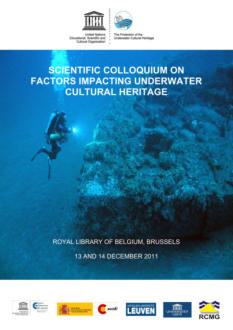

Amongst the detrimental man-made impacts to which
shipwrecks are susceptible – such as sand and gravel
dredging, pipeline cutting, and looting – the pressures of
the global fishing industry are understated. Recent research
has led to a growing concern that trawling and scallop
dredging are high on the list of the most aggressive forms
of anthropogenic impact on the resource. The classes of
artefacts inadvertently snagged in nets reveal a
geographically and typologically wide set of data. The
damaging reality may be compared to the effects of
ploughing on terrestrial archaeological sites. Underwater,
however, no policies have been formulated to manage and
mitigate offshore fishing politically or to recommend best-
practice guidance. This report presents global evidence for
the history of bottom fishing impacts on underwater
cultural heritage and examines the diversity of impacted
finds and sites through 68 examples and case studies.
Potential forms of mitigation and management are
discussed.



Authors:
Will Brouwers, Johan Opdebeeck, Rodrigo Torres, & Thijs
Coenen
A shipwreck of the Dutch admiralty in the Baía de Todos os
Santos, Brazil: its history from battle to archaeological
assessment



Authors:
Jennifer F. McKinnon, Toni L. Carrell
This project focuses on the underwater cultural heritage
(UCH) remains from the World War II (WWII) Battle of
Saipan that occurred in June and July of 1944 in the
Commonwealth of the Northern.
Mariana Islands (CNMI). This project builds upon a 2009
ABPP grant (WWII Invasion Beaches Underwater Heritage
Trail GA-2255-09-028) to survey and map the submerged
archeological sites from the Battle.
(McKinnon and Carrell 2011)

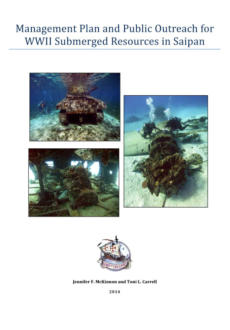

This book explores approaches to the interpretation of
shipwrecks, an archaeological site type with specific qualities
and associated challenges and potentials. It is not a book
about shipwreck archaeology in the sense of methodology,
neither is it a study of ship technology in terms of their
design and construction processes, nor a synthesis of past
work in any general sense. Instead, it is a series of
explorations of how scientists experience and interpret the
remains of past human activity in the form of one of its most
complex manifestations.



This paper highlights aspects where a small ROV has the
potential to provide significant benefits, making a case for
more widespread use of this technology within the
Australian maritime archaeological sphere.
In particular, the author focuses on applying ROVs in
underwater cultural heritage management and underwater
imaging and shows examples of work where ROVs have
already been used with excellent results.

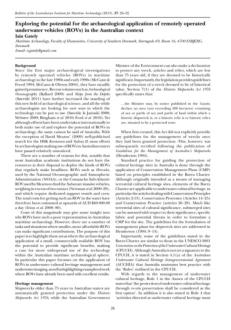

Authors: Davíð Bjarni Heiðarsson.
This thesis aims to analyze underwater heritage
management in Iceland and make it available and
understandable to archaeologists and people without an
academic background. This thesis focuses on protection by
comprehending the threats and addressing them without
great excavations since it is the authors’ opinion, supported
by the 2001 Underwater Cultural Heritage Convention.

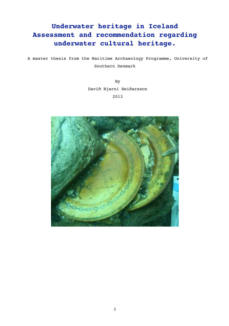

Author: Johan Opdebeeck
This document explains the laws and procedures in force in
the Netherlands and the action undertaken to protect the
archeological heritage threatened by the extension of the
harbour activities in the northern part of the Netherlands,
which comprised a larger seaway to the port of Eemshaven
and the creation of an anchorage outside the harbour.

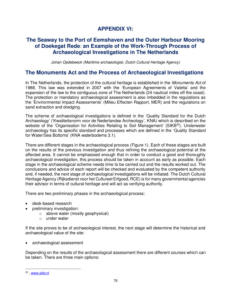

Authors: Tori Falck & Jostein Gundersen.
This document explains the procedures implemented to
investigate and preserve potential archeologic remains
during the construction of a new immersed tunnel passing
through the central harbour of Oslo.



Authors: Michael P. Fedoroff, Jeffrey M. Enright, Nick
Linville, Larry Parson.
To investigate Mobile harbour in Alabama, United States,
before dredging, the United States Army Corps of Engineers
(USACE) developed a predictive model for potential
submerged cultural resources based on the area's
environmental characteristics and maritime history. The
predictive model was used to determine the potential for
historic shipwrecks near the project location and their likely
design, composition, and age.



Author: Chuck Meide
It was some time before archaeologists working on
underwater sites regularly utilized theoretical frameworks to
interpret their work better, as were their terrestrial
counterparts. As late as the 1970s, Keith Muckelroy
(1978:10) noted that maritime archaeology displayed “a
remarkable lack of development or systematization,”
constituting an “academic immaturity” when compared to
other archaeological sub-disciplines.

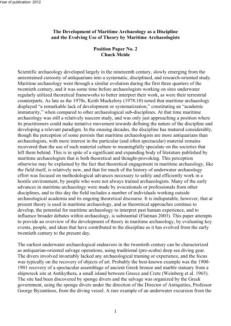

Authors:
Thijs Maarleveld and Alice Overmeer, with contributions by
O. Brinkkemper, F. van Deijk, W.M. Gijsbers, E.M. Jacobs, C.
Joosten, M. Terhorst, A.D. Vos
In 1635 or shortly thereafter, a Dutch ship was laden with
all sorts of materials and products, mostly metals but also
textiles from the booming wool industries in both Flanders
and Holland, a shipment of leather and exotic ivory. This
ship of considerable size departed from the Dutch Republic
at a time of profound troubles for a destination it never
reached. It sank off the coast of Texel, where it was
discovered 350 years later.



Authors: Hayat Erkanal, Vasif Sahoglu, & Irfan Tuggu
“Izmir Region Excavations and Research Project 1 ” was
begun in 1992 with Urla/Liman Tepe Excavations led by
Hayat Erkanal. Excavations have been ongoing since 2006
by Ankara University Research Center for Maritime
Archaeology (ANKÜSAM) 2, which has now completed its
institutionalization process.
The project consists of four excavations on land, two
completed, two ongoing, and underwater excavations.



Authors: Hayat Erkana, Vasif Sahoglu, IrfanTugcu
“Izmir Region Excavations and Research Project" began in
1992 with Urla/Liman Tepe Excavations led by Hayat
Erkanal. Excavations have been ongoing since 2006 by
Ankara University Research Center for Maritime
Archaeology (ANKUSAM)2, which has now completed its
institutionalization process.
The project consists of four excavations on land, two
completed, two ongoing, and underwater excavations.



Document provided by provided by Chealsea Freeland
Stem to Stern is a magazine published annually by the
Program in Maritime Studies
(https://maritimestudies.ecu.edu/)
The Maritime Studies Association (MSA) is the official
student-run group for the Maritime Studies Program. It
provides opportunities for students to expand their
education through events like presentations by professionals
in the field of maritime archaeology, field trips to historical
vessels, and advanced dive training through ECU’s Office of
Diving and Water Safety.



Author: Padraig Cronin
The concept of writing legislation that covers an
international spectrum for protecting and managing any
finite resource is fraught with difficulties. Firstly, different
ideas and viewpoints exist in each country's understanding
and definition of what is essential heritage and protected
heritage. Secondly, a public's perception and changing
attitude towards maritime culture, the interpretation of
what is heritage, and thus in need of documentation and
protection is an ever-changing complex term to define.

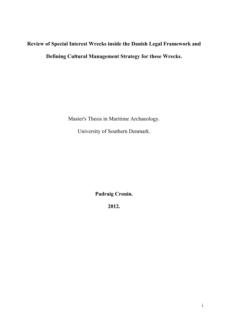

Author: Alberto Frigerio
This dissertation investigates the underwater cultural
heritage from a multidisciplinary approach, sustained by
argumentative reflections, comparative analysis and
problem solving techniques in a combination
of theoretical, legal and managerial perspectives. The main
purpose is to provide a complete, dynamic and innovative
framework of analysis that may also serve as a guide for
implementation.

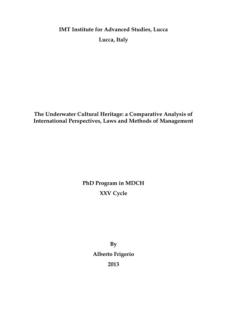

Author: Christopher Todd Dewey
This paper examines the site formation processes of the U. S.
Steamer Convoy that burned and sank in Pensacola Pass in
March 1866 and the search for the Confederate Schooner
William H. Judah that burned and sank in the same vicinity
five years earlier.



Author: Alberto Frigerio
This document investigates the underwater cultural
heritage from a multidisciplinary approach, sustained by
argumentative reflections, comparative analysis, and
problem-solving techniques in a combination of theoretical,
legal, and managerial perspectives. The main purpose is to
provide a complete, dynamic and innovative framework of
analysis that may also serve as a guide for implementation.



Author: Mark Staniforth
The Australian Historic Shipwreck Preservation Project
(AHSPP) has focused on the reburial and in-situ preservation
of shipwrecks and colonial shipbuilding. In 2011 researchers
identified a number of criteria that a research site should
meet in addressing these topics including a) the shipwreck
must be identified at risk; b) the site should be logistically
accessible; c) the site has been extensively researched,
monitored, and perhaps partially excavated previously; and
d) the current managing agency must supports the AHSPP
and have the capacity to carry out the long-term monitoring
of the site.





Click on the
octopus to return to
the top of the page





6 - L'epave la Madrague de Giens et la plaine de Fondi. Producteurs
des vins, des amphores Dr.1b et commerçants.
Authors: Antoinette Hesnard
The excavation of the shipwreck La Madrague de Ciens
and the study of the Fondi plain and amphorae have
provided important information about wine production
and marketing in the 1st century BC. The findings clarify the
roles of different actors in the wine trade. The data from
thousands of amphorae and thorough wreck excavation
ensure reliability. Workshop marks and geometric stamps
confirm a system used by merchants for tax control during
transport.












